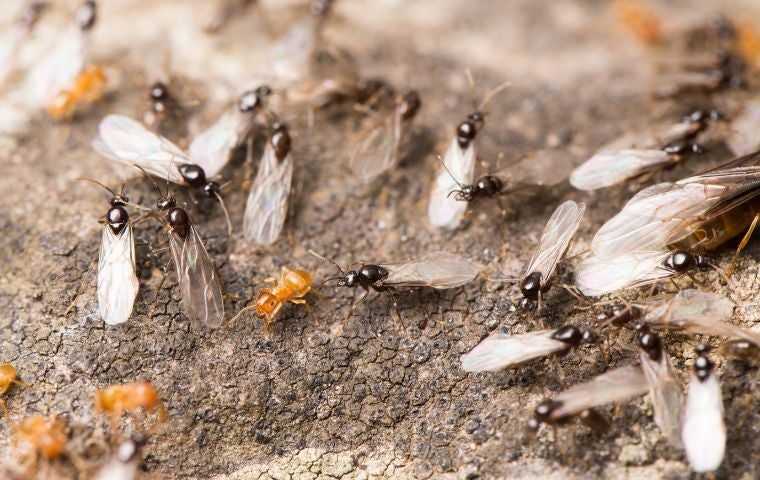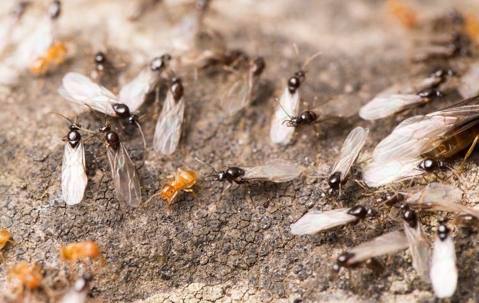Do Flying Ants Bite?
September 07, 2023 - Ants

Yes, flying ants are capable of biting. Flying ants are not a distinct species but rather reproductive ants in a colony, typically the winged males and females. Their primary purpose is to mate and establish new colonies. While their main focus is on reproduction, they do possess mandibles that they can use to bite if they feel threatened or provoked. These bites are generally not aggressive, and flying ants do not pose a significant threat to humans. However, their bites may cause mild discomfort, akin to a small pinch. It's important to note that flying ants are not as aggressive as some other insects like wasps or hornets, which can deliver more painful stings. In most cases, encountering flying ants should not be a cause for concern, and they are unlikely to bite unless handled or provoked.
Flying ants, as mentioned earlier, are the reproductive members of an ant colony. They play a crucial role in the ant life cycle by participating in the mating process. These ants typically develop wings during specific times of the year, often triggered by environmental factors like temperature and humidity. Once conditions are favorable, flying ants emerge from their nests in swarms, engaging in mating flights.
Mating for flying ants occurs in the air, where males and females from different colonies come together. After mating, the male ants generally die, while the fertilized female ants, known as "queens," land to start new colonies. These queens shed their wings and search for suitable nesting sites, where they lay eggs and establish a new ant colony.
Regarding their bites, it's important to note that flying ants do not actively seek out humans to bite. Their bites are primarily a defensive mechanism. When handled or threatened, they may use their mandibles to nip in self-defense. These bites are usually not painful for humans and are unlikely to cause any significant harm.
The life cycle of flying ants varies depending on the ant species and environmental factors. In some regions, you may observe flying ants during the summer months, while in others, it may occur in the spring or early fall. The timing of their emergence is closely tied to the needs of their particular species and the conditions that favor successful reproduction.
Flying ants are often mistaken for termites due to their similar appearance when they have wings. However, there are distinct differences between the two. Termites have straight, bead-like antennae, while flying ants have elbowed antennae. Additionally, the body structure of flying ants features a noticeable constriction between the thorax and abdomen, which is absent in termites.
One interesting aspect of flying ant behavior is their attraction to light sources, such as streetlights or porch lights. This phenomenon can sometimes lead to swarms of flying ants gathering around these sources during their mating flights. While it may be a nuisance, it's important to remember that these swarms are short-lived, usually lasting for only a day or so.
To prevent encounters with flying ants around your home, you can take simple precautions, such as ensuring screens on doors and windows are intact and keeping outdoor lights turned off when not needed during the flying ant season.
If you encounter flying ants, there are some steps you can take to handle the situation calmly and effectively:
Avoid Panic: Flying ants are a natural part of the ant life cycle and are generally not a cause for alarm. Stay calm and composed.
Do Not Disturb: Avoid provoking or handling them. Flying ants are more likely to bite if they feel threatened. Simply observe from a safe distance.
Identify: Confirm that they are indeed flying ants and not termites, which have a similar appearance. As mentioned earlier, flying ants have elbowed antennae and a distinct waist, while termites have straight antennae and a thicker, less defined waist.
Close Windows and Doors: If you have open windows or doors, close them to prevent the flying ants from entering your home.
Turn Off Lights: If flying ants are swarming around outdoor lights, consider turning them off temporarily to reduce their attraction to the light source.
Wait It Out: Flying ants are usually short-lived, and their swarming period can last a day or less. They will disperse naturally once their mating flights are completed.
Prevent Entry: Check for any gaps or cracks in doors, windows, or screens that could allow flying ants to enter your home. Seal these openings to prevent their entry.
Clean Up: After the flying ants have dispersed, you can clean up any remains they may have left behind, such as discarded wings. This helps maintain cleanliness and hygiene.
Seek Professional Help (If Necessary): If you have a persistent problem with flying ants invading your home, consider contacting a pest control professional for assistance in identifying the source and implementing effective solutions.
Remember that flying ants are a natural occurrence and pose no significant threat to humans. By following these steps, you can peacefully coexist with flying ants during their brief mating season without major disruptions.
Customer Review
Bret came to our home to treat our pest issues same day and was thorough and knowledgeable! Pricing was lower than 4 other companies I'd contacted. Highly recommend!


